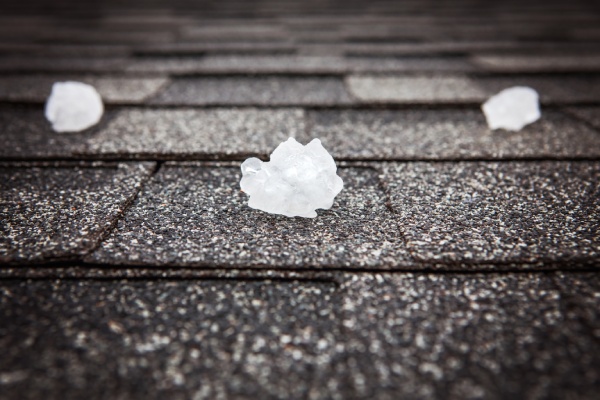Your roof is the first defense against the elements protecting your home and its inhabitants. Numerous things can damage the roof. These include:
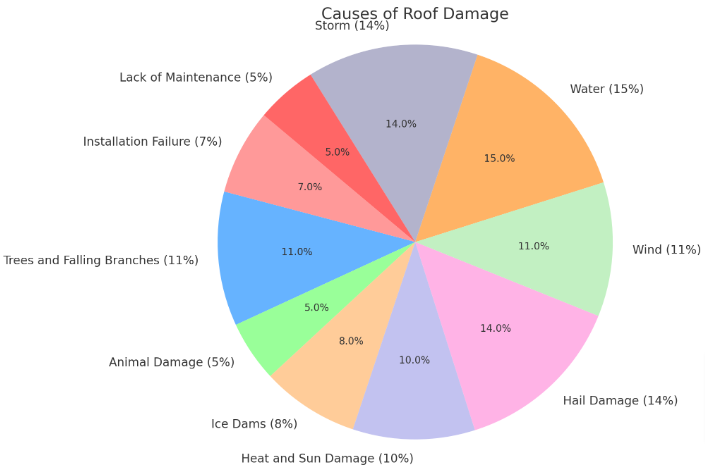
Among the various weather-related challenges your roof faces, hail can be particularly damaging and often misunderstood. This article will discuss hail damage to your roof, its impact, and the importance of early detection for maintaining the integrity of your roof and, by extension, your entire home.
How Does Hail Damage Affect Your Roof
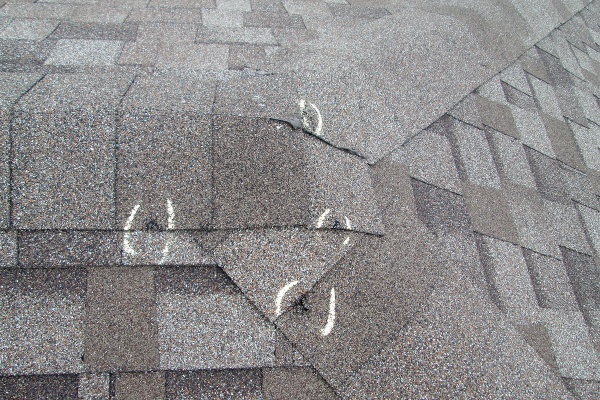 Hail damage refers to the physical harm caused to your roof by hailstones during a storm. These impacts can range from minor cosmetic issues to severe structural problems that compromise your roof’s ability to protect your home. The extent of damage depends on factors such as hailstone size, wind speed, and the type of roofing material.
Hail damage refers to the physical harm caused to your roof by hailstones during a storm. These impacts can range from minor cosmetic issues to severe structural problems that compromise your roof’s ability to protect your home. The extent of damage depends on factors such as hailstone size, wind speed, and the type of roofing material.
Hail can:
- strip away protective granules on asphalt shingle roofs;
- expose the underlying material to harmful UV rays and other weather elements.
- accelerate your roof’s aging process,
- potentially lead to leaks and other roofing issues sooner than expected.
Common Misconceptions About Hail Damage
- Hail damage is not always immediately visible.
- Only large hailstones can cause significant damage.
- Minor hail damage is insignificant and does not require immediate attention.In reality, even small hail can inflict considerable damage, and the impact may not always be apparent to the untrained eye. Even minor dents or cracks can become major problems if not addressed.
The Crucial Importance of Early Identification
Identifying hail damage soon after occurrence is paramount to maintaining your roof’s integrity and preventing more severe issues. Hailstorms can leave visible and hidden damage that, if not addressed, can lead to severe problems. Early detection allows for timely repairs, potentially saving you from costly roof replacements and protecting your home from secondary damage such as leaks, mold growth, and compromised insulation.
How Hail Damage Affects Roof Longevity
The impact of hail damage on your roof’s lifespan can be significant. Hail strips away protective granules or may crack shingles, exposing your roof to accelerated wear and tear. This exposure can lead to:
- Premature aging of roofing materials
- Increased vulnerability to future weather damage
- Potential water infiltration, leading to structural issues
- Decreased energy efficiency due to compromised insulation
By understanding these aspects of hail damage, you’re better equipped to protect your home and make informed decisions about roof maintenance and repairs. In the following sections, we’ll explore how to identify signs of hail damage to the roof and the steps you should take to address it effectively.
Signs of Hail Damage to Look For
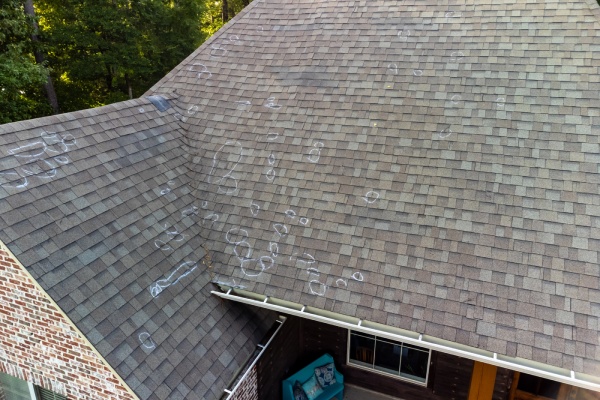 Now that we understand the importance of identifying hail damage let’s explore the specific signs to look for on your roof. Recognizing these indicators can help prevent minor issues from escalating into major problems.
Now that we understand the importance of identifying hail damage let’s explore the specific signs to look for on your roof. Recognizing these indicators can help prevent minor issues from escalating into major problems.
Visible Signs on Roof Exterior
The most apparent signs of hail damage are often visible on the exterior of your roof. Here’s what to look for:
- Dents on metal components: Inspect gutters, downspouts, and metal flashing for minor dents or dimples. These imperfections are clear indicators of hail impact and may suggest hidden damage to the roof itself.
- Granule loss: Granules are essential for providing UV protection and helping preserve the roofing material’s integrity. Check for an accumulation of these granules in gutters or on the ground below your roof, as significant loss can expose the underlying material to harmful elements.
- Cracks or fractures: Examine your shingles closely for visible cracks or fractures. These often appear where hailstones have impacted the roof and can lead to water infiltration if left unaddressed.
- Debris: Look for shingle pieces or other roofing materials around your property. The presence of such debris often indicates significant damage from a hailstorm.
Less Obvious Signs
Some signs of hail damage may not be immediately apparent but are equally important to identify:
- Soft spots: While inspecting your roof, gently press on various areas to check for soft spots. These can indicate water accumulation beneath the surface, potentially leading to leaks and structural issues.
- Damaged roof valleys: Pay special attention to the valleys on the roof, as these areas are critical for proper water drainage. Look for signs of denting, buckling, or any irregularities that could impede water flow.
Interior Signs
Sometimes, the signs of hail damage may manifest inside your home:
- Water stains: Be vigilant for water stains on ceilings or walls. These can indicate leaks from hail damage that has compromised your roof’s integrity.
It’s worth noting that some damage may not be visible to the untrained eye. Look for bruising, which may not be visible but can be felt by running your hand over the surface. This technique is particularly useful for identifying damage on asphalt shingles.
Given the variety and sometimes subtle nature of hail damage signs, a thorough roof inspection after hail damage by a professional is often the best way to ensure all damage is identified and addressed promptly. Remember, early detection and repair can save you from more costly issues down the line and help maintain the longevity of your roof.
Steps to Take After a Hailstorm
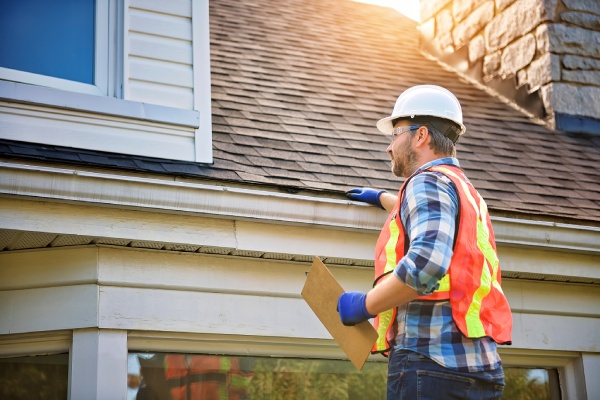
Once you’ve identified potential hail damage to your roof, it’s crucial to take prompt action to mitigate further damage and initiate the repair process. Here are the essential steps to follow after a hailstorm:
1) Prioritize Safety:
- Inspect your surroundings for immediate hazards.
- Ensure your family and pets are safe indoors.
- Wear protective clothing if you need to assess the damage outside.
- Avoid climbing onto the roof, as it can be slippery and pose serious injury risks.
2) Document the Damage
- Document the damage to your property thoroughly.
- Take detailed photos and videos of all affected areas.
- Capture images from various angles and distances to view the damage comprehensively.
- Keep a written record of observations and conversations with insurance adjusters.
3) Make Temporary Repairs
- Make temporary repairs where possible.
- Use tarps or plywood to cover holes in the roof or walls.
- Ensure these temporary coverings are securely fastened to protect your home’s interior from water damage.
- Keep receipts for materials used in these temporary repairs for reimbursement from your insurance policy.
4) Schedule a Professional Inspection
Schedule a thorough inspection by a professional roofing contractor as soon as possible.
They have the expertise to identify hidden damage that may not be visible to the untrained eye.
5) File an Insurance Claim
- Initiate the insurance claim promptly.
- Provide them with all relevant documentation.
- Be present during the inspection from an adjuster to point out any damage you’ve identified and share any additional documentation that supports your claim.
By following these steps, you can effectively manage the aftermath of a hailstorm and ensure that your roof receives the attention it needs. Prompt action and thorough documentation are key to protecting your home and facilitating a smooth repair and insurance claim process.
Hail Damage Repair and Prevention
After identifying hail damage and taking immediate steps to protect your property, the next crucial phase is addressing the repair process and implementing preventative measures for future protection. This section will guide you through the key considerations for effective hail damage repair and long-term roof maintenance.
DIY vs. Professional Roof Inspections and Repairs
While DIY inspections can be a good starting point, they have limitations. Conducting a DIY inspection can help you identify apparent damage and prevent minor issues from becoming major problems. Unfortunately, DIY approaches may miss subtle signs of damage that a trained professional could spot.
Professional roof inspections, however, offer a thorough assessment of your roof’s condition. Experienced inspectors can identify visible and hidden damage, providing you with a comprehensive report and repair recommendations. Professional repairs are often necessary for complex or extensive damage to ensure the work is done correctly and safely.
Choosing a Trustworthy Roofing Contractor
Selecting the right roofing contractor is crucial for quality repairs. Here are some key steps to follow:
- Check credentials: Verify that the contractor is licensed, insured, and bonded.
- Read reviews and ask for references: Research online reviews and speak with previous clients to gauge the contractor’s reputation and work quality.
- Get multiple quotes: Obtain estimates from several contractors to ensure fair pricing and comprehensive service.
Standard Hail Damage Repair Methods
The repair methods for hail damage can vary depending on the extent of the damage and the type of roofing material. Standard repair techniques include:
- Replacing damaged shingles
- Patching small holes or cracks
- Repairing or replacing damaged flashing
- Addressing underlying structural issues, if presentFor extensive damage, a complete roof replacement might be necessary. A professional assessment can help determine the most appropriate repair method for your roof.
Preventative Measures to Protect Your Roof from Future Hail Damage 
While it’s impossible to control the weather, you can take steps to minimize future hail damage:
- Choose impact-resistant materials: When replacing your roof, consider investing in shingles or other durable roofing materials to withstand hail impacts.
- Regular maintenance: Regularly inspect and maintain your roof in good condition, including gutter cleaning, removing debris, and addressing minor issues promptly.
- Install protective barriers: Consider adding hail guards or other protective measures to vulnerable areas of your roof.
If you are concerned about potential hail damage to your roof, contact Frontline Home Solutions for a complimentary roof inspection in the Rio Grande Valley and complete repair services to ensure your home remains safe and secure.
Our experienced team provides comprehensive evaluations and transparent estimates, helping you make informed decisions about necessary repairs. Don’t wait for minor issues to become major problems; schedule your free roof inspection today and protect your investment.

